Blue Reflection: Second Light is a delightful JRPG that forges its own unique, if rough around the edges, identity
- Developer: Gust
- Publisher: Koei Tecmo
- Release date: 9th November 2021
- Genre: JRPG
- Platforms: PS4, Switch, Windows PC
- Reviewed on: PS5 via backward compatibility
- Game Supplied by: Publisher
Blue Reflection: Second Light Review
If ever a game developer was deserving of an award for its consistency in producing quality games then Gust would be near the top of the list. Still basking in the success of the Atelier Ryza series, and in between working on the recently announced Atelier Sophie 2, Gust has somehow found the time to sandwich in yet another title. Blue Reflection: Second Light holds its own amongst this heavyweight company, however, it does show some cracks that the more polished games in Gust’s library don’t have.
For new players starting with Blue Reflection: Second Light, you will be welcomed by some of the best in-game tutorials I’ve experienced in the genre. Clear and simple instructions are delivered in a timely manner so you are not overwhelmed with systems all at once. For me, it is the new benchmark of how to incorporate tutorials into a game.

Although I haven’t played the first critically acclaimed Blue Reflection game, I didn’t feel like Blue Reflection: Second Light left me wondering what I had missed; It’s very easy to start without any prior knowledge of the series. However, the setup of the premise of the game, with the whys and wherefores did have me scratching my head at what was going on at times.
You start as one of four high school girls (Ao) who find themselves alone in a school, surrounded by water, and with no memory of how they got there or of the world they have come from. The only areas to adventure into are called “heartscapes”. During the exploration of these heartscape lands, the girls find memory fragments that fill in the blanks for one of them, that recalls memories of what they did in the real world. These memories, however, all have themes such as fear or regret, and it’s the emotions of the situation they faced that created the “heartscape” land in the first place. Defeat their real-world fear and they will conquer the heartscape.
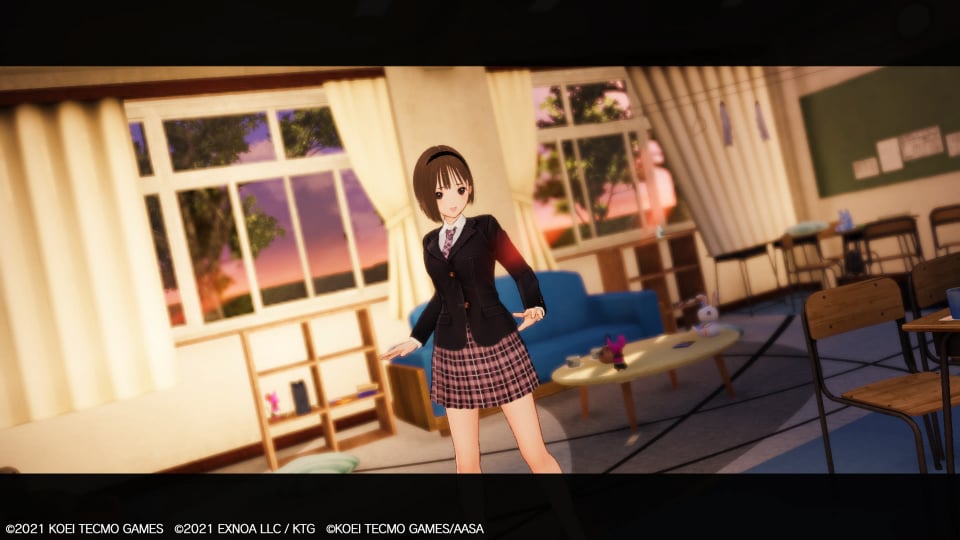
One thing the game can not be accused of is a boring narrative or story, as alongside some excellent voice acting, the pull of the game is finding out about each girl, what makes them tick, to then see them grow and become more confident when they face the fear they are trying to defeat. It’s a similar structure as seen in Persona, where the players had to change the heart of the target, but here in Blue Reflection: Second Light, the final key will be to defeat a boss, rather than find a treasure.
What makes this journey so pleasing is that the longer you spend with each character, the more the differences in their personalities shined through. Yuki was by far the funniest, Rena, very serious, and the rest were somewhere in between, sharing typical JRPG character tropes.

The nuances of the individual characteristics of each girl are highlighted and explored even further by the social aspects of the game. The girls each find their own roles in the world while they try to understand and escape it, and to help them achieve this, you can rank up with them in various ways. They can request you do side missions for them or you can talk to them via texting or even go on dates with them! Each action unlocks new information about the girls and increases your bond with them, which has the practical advantage of giving you Talent Points (TP) to then use to upgrade each character.
Completing main missions will also give you talent points to spend, but it was never a chore to spend more time with each girl in the side quests and dates. In fact, these actions put so much more flesh onto the story, and a lot of talent points, it made it all the more worthwhile.
Talent Points were very key and varied. Some added a simple amount of health points whereas others boosted a character’s speed, defence or ability to unlock extra slots for item buffs to be added. It was a pleasant headache deliberating over which upgrade to spend the precious talent points on, as each talent felt significant to acquire. As you play the game you then learn to focus upgrades on certain characters.

The crux of the gameplay comes from exploring each dungeon (Heartscape) to find memory fragments, before defeating a final boss, then moving on to someone else’s heartscape.
Each dungeon is filled with demons to defeat and items to find. The items can be used to craft consumables ranging from stat buffs to simple health items. The crafting system operates like a very simple, slimmed-down version of that found in an Atelier game. Other items to craft include axes or materials (like wood) to build new areas within the school. When these new areas are built, they give the whole team permanent stat increases, so the more things you build around the school, the stronger the team becomes.
The real-time turn-based battle system has obviously had a lot of effort put into it. Within the HUD is a timeline of your characters moving right to reach targets on the line, or the enemy moving left to invoke their attacks. The beauty of the system is that for the girls there are five points along the line. When they reach the second point, for example, they can then use two consecutive attacks in one go: When they reach the third point, they can then use three and so on. Additionally, when reaching the third point they transform into their powerful version, which increases their attack and defence strength.
It’s a frightfully tense system as you are constantly having to weigh up on the fly whether to do a single attack now or wait just a bit longer for the double attack, but doing so will allow the enemy time to get their hit in. The most enjoyable tactic for me was allowing one of my team enough time to get as far along the scale as quickly as possible, while the other two just put in single hits. The attacks the girls use also have elemental and action buffs that enemies are either weak, normal or resistant to, which adds an extra layer of tactics to the battles.
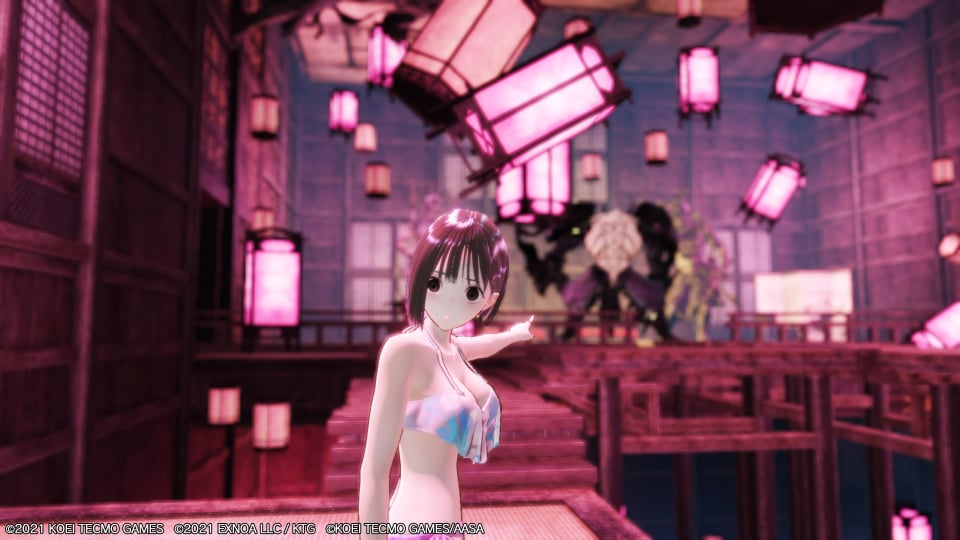
If the enemy is building up for a powerful attack, using one of the characters special abilities at just the right moment deflects a lot of the power of the incoming attack, but most importantly ensures that the combo meter you have been building doesn’t reset. As we all know, the longer the combo, the more powerful the hits become.
Another layer that is added later is that as more girls join the party, they can be used as support members by either dishing out items or stat buffs to the active team.
Farther into the game, there are occasions where you can unlock one on one standoff battles, midway through a fight; This only applies to tougher enemies and locks one of your team into a duel. This is nothing more than a slimmed-down version of the main battle system. You again have a timeline but all the actions are basic and have to be timed perfectly to work. It’s a little too fast and frenetic, but get it right and you will be rewarded by dealing a huge amount of damage to the enemy.
The only issue with combat is that you have to constantly look at the battle timeline and nothing else, as things do move very fast. This means you don’t get to enjoy what the characters are doing on-screen during battle, with their over the top battle animations and hits. A lot of the interesting animations were lost to me simply because even though I knew one of my characters was landing a hit, I was already focusing on the timeline for my next action, so my eyes were always diverted down and away.
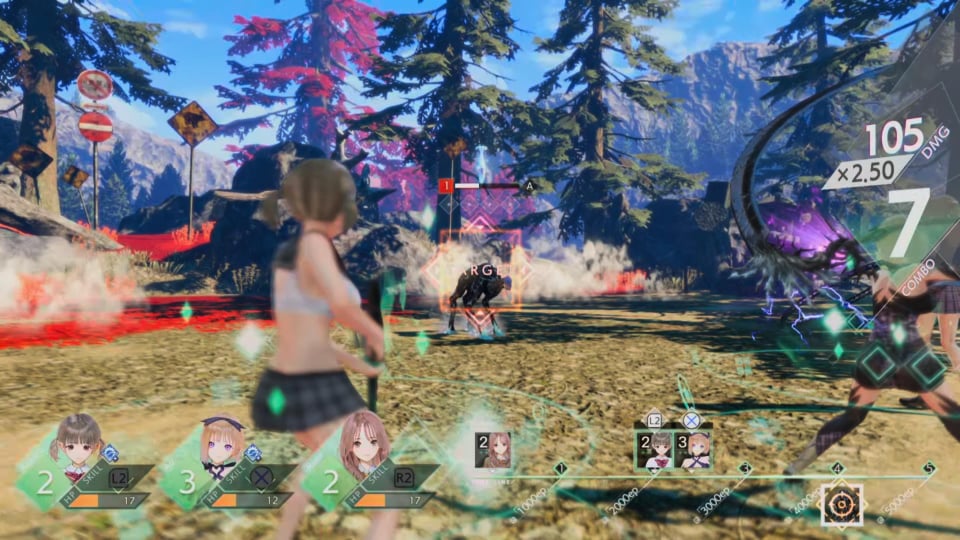
For a game that is trying to find a halfway house between real-time fighting and turn-based action, this is the drawback you will get. It was only by watching back some video of what I had done that I noticed some of the nuances of the game I had missed before, as I was staring at nothing else than the timeline during combat.
During the dungeon exploration, there is some stealth gameplay, although I use the word stealth in the most liberal of terms. Pressing the circle button darkens the screen and shows the enemies area of attention in red. This will allow you to find ways past the enemies if you don’t want to fight them, and indeed there are even stealth missions where being spotted results in failure. This aspect of the game, although helpful if you are low on supplies nearing the end of a dungeon and just want to avoid fighting for a short time, is not going to be threatening Agent 47 any time soon. Like a lot of the game, it was all a bit clunky and stiff, but serviceable and useful.
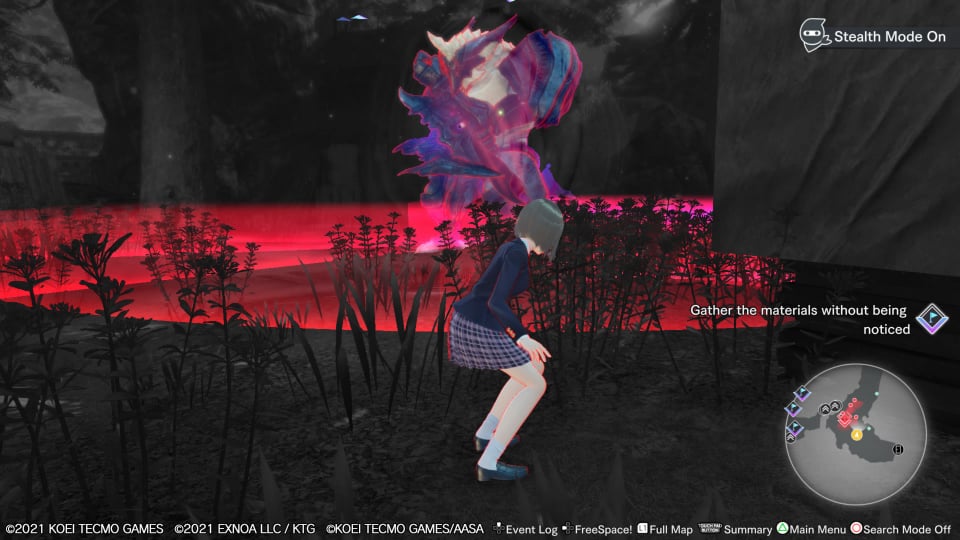
Then we get on to the mixed bag that is the graphical prowess. This is a Gust game, and as usual, the artwork is outstanding. Character models are beautiful to look at, and in reviewing this game, I took a ridiculous amount of screenshots to capture a moment I thought looked awesome. There is even a photo mode, which is fun and simple to use. When you pause the game and take pictures the world looks gorgeous, it’s just when things start moving again it feels like the engine running it is from a higher-end PS3 game than a PS4 one, especially during the flashy combat moves.
Even with world environments that aren’t particularly filled with a lot of detail, the game engine really seems to struggle with keeping the visuals smooth or there just wasn’t enough attention given to the animations, with some moves over in what felt like 3 or 4 frames. Trying to capture the moment of landing a scythe blow to an enemies head took a lot of toing and froing with the video as the movements of the scythe were so stuttery. When the girls are gently walking around the world outside of combat their movements are very stiff, but their clothes do at least move realistically with them.
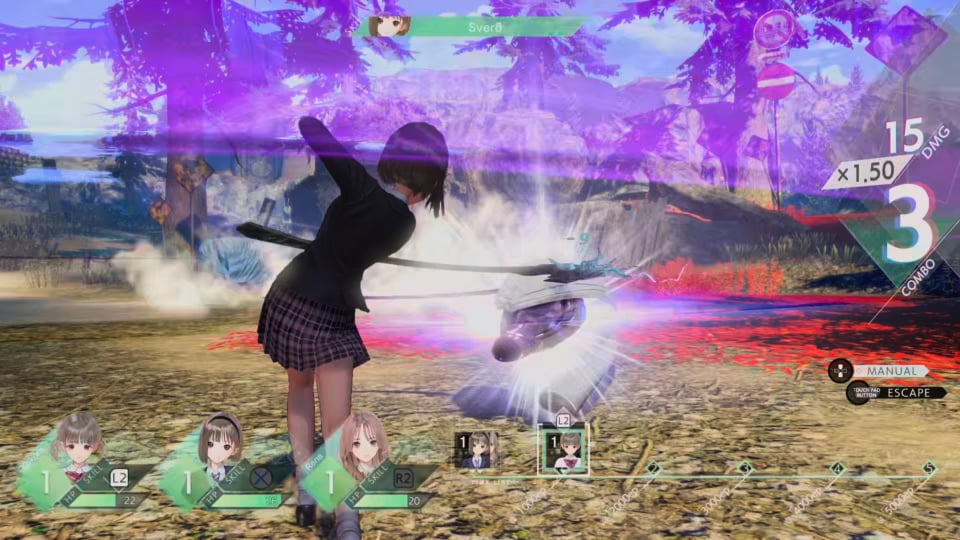
Despite this, the artwork is stunning. The character models are interesting, and the world vibrant and varied, although the developers do seem to have a perpetual need to oversaturate the brightness of the sun; This causes the game to occasionally look blurry as if you are looking into the real sun itself.
Finally, the audio of the game is excellent. The voice acting, even for someone who doesn’t understand Japanese, really conveys the feelings and emotions the girls were going through. For a game based around their internal emotional struggles, it was a key aspect they had to get right but they nailed it. For example, the character Kokoro begins her heartscape journey as a timid girl, but by the end, as can be heard in the tone of her voice, she has quite clearly changed to become more confident. Then there were times she was upset, which again you could feel in the weight of her performance.
The action noises during battle are also excellent, but not in a meaty, weapon meets flesh kind of way. In keeping with the atmosphere of a “magical girls” experience, they have kept the effects light and dare I say sparkly! Slay demons with a sprinkle of fairy dust and a wisp of colour, not a thunk and splat of blood on a surface.
The soundtrack of Blue Reflection: Second Light is also superb. Mainly composed on a grand piano or other keyboards, I’d love for them to make the in-game music available to purchase. They are not tunes to get the blood pumping, but they most certainly are something you could relax, fall asleep or study with.
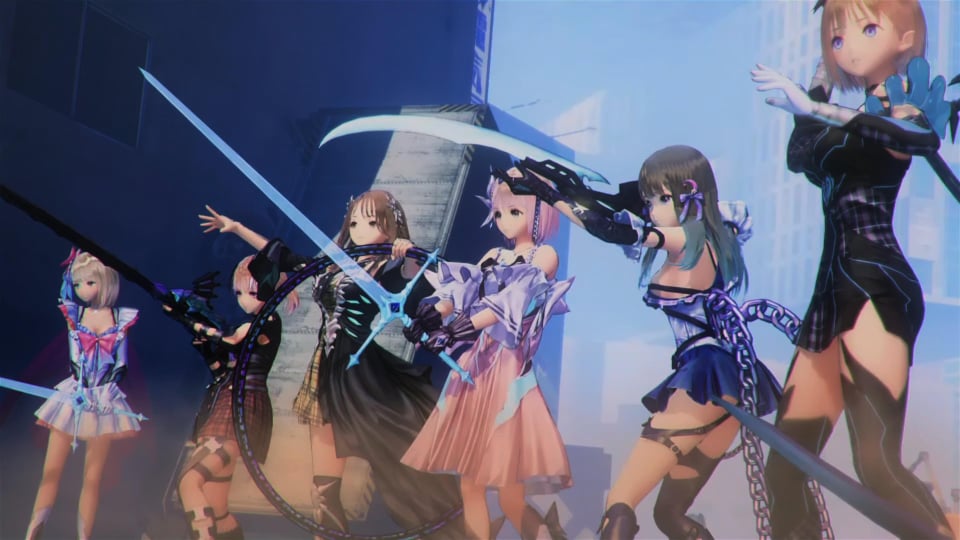
Summary
Blue Reflection: Second Light may not offer anything new to the JRPG genre that would warrant top marks, but everything it does is done very well. The story is interesting and full of great performances and characters, the combat systems are thoughtful and tactical, allowing the player to experiment and learn on the job, and beautiful music accompanies the gorgeous artwork. If only more attention were paid to the animations this could have been superb.
As it is, it’s still a really interesting game. Even though it uses aspects found in other games, it puts them together in a way that makes Blue Reflection: Second Light feel unique. It’s a magical journey befitting a magical game, from a magical developer.

